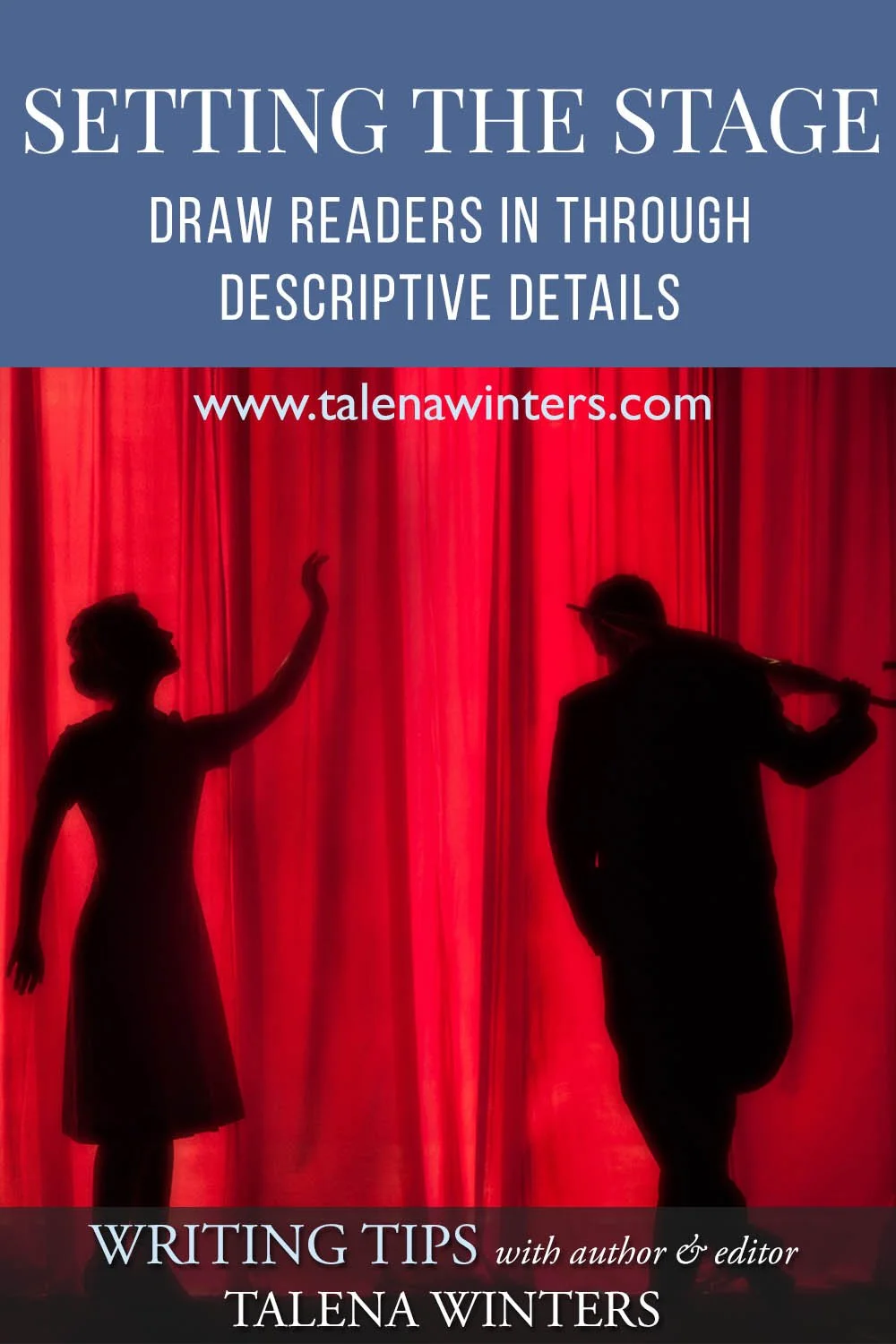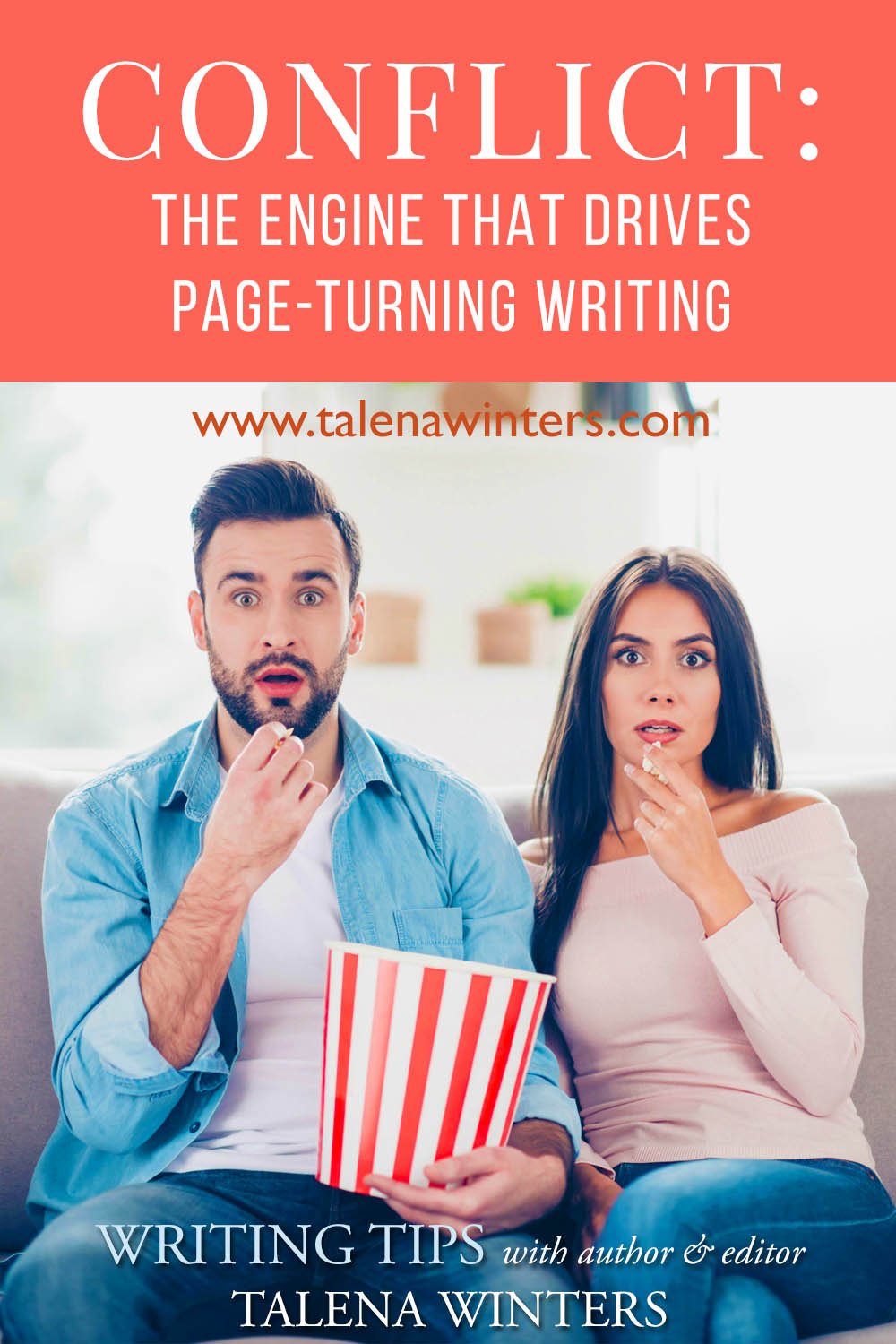Setting the Stage: Draw Readers in through Descriptive Details
When it comes to giving descriptive details about settings and characters, there are two ways to err:
Not giving enough details to allow the reader to be visually grounded in a scene.
The dreaded info-dump—piles of description that are completely unrelated to plot or action.
The first results in frustrated, confused readers who can’t follow a scene because actions or late descriptions conflict with what they had already pictured. The second results in frustrated, bored readers who walk away because they just couldn’t read another page about the architectural history of Notre Dame Cathedral, or the steppes of the neolithic world. (For the record, I read every page of those linked books… the first time.)
I find the most common problem is not giving enough information at the right time for readers to see what you see.
Now, much like Goldilocks’s assessment of, well, everything, the “right” amount of description tends to be subjective and a matter of personal taste. However, no matter how much you include, there is a right and a wrong way to include it.
Okay, scratch that. Let’s remove the moral judgements. Instead of “right” and “wrong,” think “engaging” and “boring.”
So, let’s talk about the most engaging ways to include description in your writing and suck your readers into your world with the force of a hurricane that they are begging not to release them. Onward.
How To Avoid Over- or Underdoing It:
First of all, do readers need to see everything exactly the way you see it?
No. Definitely not. For instance, if you are talking about a character walking into a Starbucks, your readers don’t have to know exactly how that particular Starbucks is set up in order for them to picture the setting and your character moving through it—unless they do.
What I mean by that is, if it is important to a later description or plot point that the space be set up a certain way, you need to describe that important detail as early as possible. Otherwise, your reader will have imagined the space one way (that is almost guaranteed to be not what you are picturing), and then when you describe something happening in a way that conflicts with their image, they are confused and thrown out of the story.
Too many situations like that and they close your book, never to open it again.
However, if a description is not going to be relevant, let your reader picture it however they want! Reading is an immersive experience—there’s a reason the hobby has survived and even flourished for over a hundred years after the invention of moving pictures. It’s the closest we get to true virtual reality. So let your readers be part of the experience. That’s why they love reading!
Besides, excessive descriptions of things that don’t matter will only slow down your pacing and make your reader silently beg for something to actually happen in the story.
That doesn’t mean you can’t include very detailed descriptions. But if you do, you need to make the things you talk about relevant in some way. And you do that by filtering them through the emotions and reactions of your character (because you’re using Deep Point of View, right?).
Here are some guidelines to help you decide if you are using description appropriately.
Include descriptions that matter as soon as possible.
We think in pictures and first impressions matter.
The moment you mention a character or a place, the reader begins to form an image in their mind. If you don’t tell them what details matter (height, hair colour, or that bum leg they’ve had since the war that means every pair of pants is too long on one leg, for instance), when you mention something later that conflicts with that image they’ve created, it will be nearly impossible for them to change their image. So every time you mention the thing that conflicts, it will throw them out of the story while they remind themselves what you are talking about.
This applies to both settings and character descriptions.
Make sure the descriptions are included in a relevant way.
This means that your descriptions will include conflict or reactions from your character’s POV.
In order to prevent the dreaded info-dump, instead of long paragraphs of description, insert relevant descriptions as action beats amongst the dialogue or character actions.
For instance, instead of introducing a new character with a full paragraph of physical traits, clothing, and back story, introduce them with maybe a sentence of what the character sees (tinged with words that reveal the character’s emotional reaction to them) and then insert other relevant descriptions and back story as action beats when it becomes relevant.
Instead of showing us everything in a scene immediately, only show us the things that the character notices in the order they notice them or when it becomes important to the action.
In Deep POV, if we as readers see something, it’s because the character sees it. (Conversely, if your character can’t see something or gather information in a certain way, neither can we unless you pull the camera back to a more omniscient point of view. Be careful doing this unless you do it throughout as a literary device.)
If the character notices something, it’s probably because it is unusual or relevant to them in some way. And if it matters to them, they are going to have feelings about it which can be revealed through the choice of words you use to describe it.
For instance, if you just met someone you find attractive, you are going to have a different reaction than if you are talking to that same person when you have a bad history with them, and the words you use to describe them will be different.
Use as many senses as possible to describe things.
Most writers depend heavily on the senses of sight and sound, which we have been trained to use for storytelling because of movies. But scents are an extremely powerful way to evoke emotions (think the smell of fresh-baked chocolate chip cookies or the gagging stench of rotting manure).
Besides those, you have taste, touch, and the internal sensations evoked by emotional reactions. We often call these “visceral reactions.” If you describe a clenching gut, grinding teeth, or knotted shoulders, we subconsciously feel those things ourselves. In other words, we become your character. And we must keep reading to find out how the tension is released.
(This is exactly why virtual reality will never replace reading completely.)
You’ve probably heard the term “show, don’t tell.” That’s what we’re going for, here. Show us enough to make your setting and characters real and alive to us, while not overloading us with details that will never matter.
Here’s an example of a piece of action that is all telling, no showing:
I went to a café this morning and bought a cinnamon bun and coffee, then sat and read my book while I ate it. The barista didn’t like my book, which bothered me.
You have a visual in your head immediately, right? It might not be very detailed, but I bet you pictured the coffee shop, the cinnamon bun, the coffee, and the book. Even the barista. However, you’re not particularly invested in the scene, and it will likely be difficult to remember much about it later. Not to mention, if there are important details about the scene—say, the name of the book, the gender or race of the barista, or even the name of the coffee shop—that will come up again later in my story, you’ll have no idea what I’m talking about. And you’ll likely have pictured the whole thing differently than I did, anyway.
That’s fine, when those things don’t matter. But when they do, you need to mention those details as early as possible, using as many senses as possible, and filtered through as much emotional conflict as possible.
However, on the other end, we have:
I walked up the street, admiring the vista of the Cool Beans storefront. A hand-chalked sign on the cobblestone sidewalk advertised a special on mochaccinos.
I stopped and stared at the facade. A black awning shielded the brick-sided building, and through the picture windows, dozens of people filled up nearly every available table, typical for a Saturday. In front of the windows, the round wooden cafe tables on the patio were just as full as the ones inside. Planters of geraniums between the tables offered the meagre illusion of privacy, and an iron boundary fence separated the patio from the common folk on the sidewalk. I went up to the glass door and walked in to the sound of chiming bells.
I’ve just written 121 words to describe this scene and, as lovely as this coffee shop is in my mind, the only part that really matters could have been said in 25—enough to tell the reader where I was going, the general atmosphere of the place, and what I did (went into the coffee shop). If my reader needed to know all that other stuff about the coffee shop, I could have included it in more relevant ways, but in this case, they don’t.
Not only that, every detail in here is visual or auditory. Walking into a coffee shop is a very sensory experience, and I should have included some other sensory details.
What’s missing here? Motivation and conflict. You have no idea why I’m going there (other than a vague, obvious one—that I probably want coffee) or anything about my character besides the fact that I have extraordinary powers of observing small details. I also care a lot about those details, taking the time to admire or notice everything about a place enough to remark on it in my mind before I go on to the next thing I intend to do. (This could be useful if you are trying to reveal that about a character, but if that’s the case, I probably should have included some kind of reactionary comment about how I feel about the setup, or whether something could be done better, or anything else that reveals my character and why I noticed these things.)
Here’s something a little more balanced with a focus on action and using sensory details as supporting elements.
I could smell the coffee before the hand-chalked sign for Cool Beans even came into view. My mouth watered at the thought of squishy-sweet cream cheese icing dripping over the edge of a delicious golden cinnamon bun. By the time I got to the till, my stomach was gurgling loud enough that a woman at a nearby café table glanced at me in alarm. Behind the counter, a perky barista in short red pigtails and a green apron rang up the order.
“That will be three-fifty, please.” She grinned as though she’d just told me I’d won the Nobel Prize.
I tucked my worn paperback copy of Pride and Prejudice under my arm and dumped my change in one hand, then sorted through it with the other.
The barista eyed my book. “I hated that movie.”
“What?” I tried not to lose count of my change while my brain searched for the meaning to her words.
Somewhere at the other end of the counter, there was a clink of porcelain hitting Formica and the aroma of warm cinnamon grabbed me by the nose. I handed the barista the cash, straining to see if the cinnamon bun at the pickup counter was mine or if someone else claimed it.
“Your book,” she said, bringing my attention back. “They made a movie, and I couldn’t stand it. Not the 2005 one, anyway. But Colin Firth. Now he’s a dreamboat. For an old guy.”
“Uh … yeah. I guess.”
I was too hangry to say what I was really thinking right then, so I accepted my receipt and hurried away to pick up my cinnamon bun and almond milk latte. But my stomach was off. I mean, how could anyone dis Keira and Matthew? They were a match made in heaven, obviously.
The coffee shop was full. I picked up my order and found a table away from the others near a window. After getting settled, I opened the book to get lost in Mr. Darcy, but all I could think of was how that barista—that modern girl who wouldn’t know what the art of civility was if it slapped her in the face—had insulted my perfect man. I loved the 2005 movie very much, thank you. It was the best one. Period. End of story.
But now, every time I saw Mr. Darcy’s name, when I wanted to picture Matthew Macfadyen, all I could see was nasty old Colin Firth. I took a bite of my cinnamon bun, and it tasted like warm mushy cardboard on my tongue. She’d even ruined my cinnamon bun!
This would all be solved very nicely if Jane Austen had ever described her characters’ looks. Then there would be no debate as to who is the best Mr. Darcy.
I glanced at the barista, but she had already gone on to the next customer. She was completely oblivious to how she’d ruined a perfectly good book-cation for me.
The first, telling example that described essentially this scenario is 33 words. The last one is 488*. However, the first one is BORING. The last one is full of conflict and specific descriptions that immerse the reader and bring the whole scenario to life. Every word reveals character, setting, conflict, and more, making us part of the scene and telling us about the people involved.
As I poked fun of in the example, in an older style of writing, it was common not to give many details about setting and character descriptions. In modern times, we want a little more. (In other books, it was common to give WAY TOO MUCH. I’m looking at you, Victor Hugo. But that was for a different audience. One without television and where picture books were hard to come by.)
Remember, we shouldn’t be smothered under an info-dump. But we also don’t want to experience “talking head syndrome”—the situation where character dialogue goes back and forth on the page with little to no descriptive detail given to invest us in either their emotions or the setting.
Here are some resources I suggest every writer add to their library that will help you with appropriate description and inserting emotional conflict into your scenes:
If you’ve been getting feedback on your writing that includes the words “boring, hard to follow, or confusing,” your descriptions may be to blame. Take a look at how and when you describe your settings and characters and make sure they are relevant, full of conflict, and put in at the appropriate time.
Happy writing!
*My Muse insisted on finishing this scene, which I posted as an exclusive benefit for my subscribers. Check out my subscription on the Books and Tea League page and look for the “Mr. Darcy and Me” Story Bite.
Talena Winters is a freelance developmental editor, independent author, magazine writer, and tea and silver lining addict. She specializes in helping struggling self-published fiction and memoir authors unlock their inner writing wizards and unleash story magic. See her editing services here.









In this first post in the “Strong Beginnings” series, we’ll explore the promises made in a compelling first act that engross your reader so completely they don’t stop reading until they get all the way to the satisfying conclusion of your story.